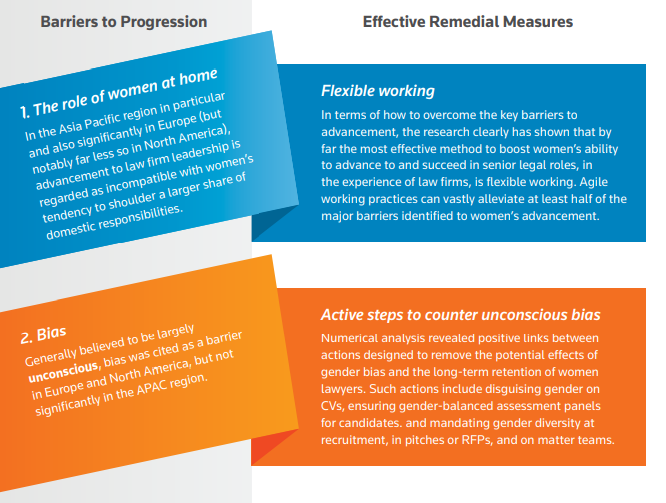Gender diversity in law firms positively impacts law firm success, research shows, with gender diverse teams in law firms achieving 10% higher client spend. More widely, organizations in the top quartile for gender diversity have been shown to be 15% more likely to achieve above average financial returns.
Despite widespread acknowledgement of the importance of achieving gender diversity, however, law firms continue to lose female talent despite showing considerable progress in hiring and retention at the entry- and mid-levels of the legal profession and within senior non-legal roles.
Acritas, part of Thomson Reuters, conducted this research for a new report, the Transforming Women’s Leadership in the Law Global Report 2020, which covers law firms in the Asia Pacific region (APAC), Europe, and North America. The study set out to show the extent of the gender diversity problem at senior levels in law firms, providing a baseline from which future progress may be measured. Also, the study investigated barriers to women’s progression into senior leadership roles and sought to evaluate the effectiveness of each approach to overcome those barriers that was identified, both as perceived by law firms and through numerical analysis.
Download your copy of Transforming Women’s Leadership in the Law Global Report 2020 via the form on this page.
Key findings
Two key barriers to women’s advancement into law firm leadership emerged, and, correspondingly, two counter-measures stood out as effective:
4 major take-aways amid the pandemic
Though the above key findings are the strongest statistically, the research uncovered a wide range of challenges that law firms face in increasing gender diversity at the leadership level. Considered collectively and in the context of other recent research, as well as within the unique circumstances of the 2020 pandemic, four major take-aways emerged.
For law firms seeking to improve gender diversity at the leadership level, the recommendations arising from this study include:
1. Leverage the “new normal” to optimize women’s opportunities into advance into leadership roles — Question all previous assumptions that may have prevented the firm from fully embracing agile working initiatives previously. Reconsider them, objectively, in light of the firm’s actual experience in 2020 (and especially during the pandemic) and gather feedback. The pandemic has been a catalyst for enormous change and is an ideal environment to change your firm for the better, permanently.
2. Build gender diversity policies and anti-bias measures into the fabric of the firm — By accepting that unconscious bias exists, law firms can best position themselves to defend against it. Gender diversity goals need to be high on the strategic agenda; and, critically, behavior that runs contrary to firm policies must be effectively addressed, without Reviewing and re-engineering practices and processes in key areas of the firm — including in recruitment, promotion, reward, work allocation, and team composition — should be done with the specific goal of redressing the effects of unconscious bias, and it should be continual.
3. Guard against initiatives that may undermine gender diversity efforts in the firm — A number of such measures have been identified — with the common theme being the erroneous perception that female lawyers are fundamentally different than male lawyers and therefore require special treatment. This false thinking potentially leads into the territory of prejudice (conscious bias). For example, well-intended women’s networks and management coaching to support parents returning to work (who are still most commonly women) can unfortunately boost these incorrect ideas. Initiatives designed to address these issues have been shown to positively impact retention and progression of women lawyers into leadership roles — and those that aim to fix femaleness are ineffective at best.
4. Collaborate with clients and other external parties to support internal efforts — Pressure from clients has been shown to have a significant positive impact on a law firm’s gender diversity efforts. Inviting client pressure by proactively asking clients what their expectations are in terms of firms’ approach to gender diversity at all levels of the firm, including in leadership roles, is a necessary first step. Firms prioritizing gender-balanced teams at all stages of the work-cycle and promoting the benefits of the whole firm being agile in its working practices have worked well for top-performing firms.
What lies ahead
The findings of this research are powerful and come at a time of great opportunity — for women lawyers, of course, but even more so for the law firms employing them. We hope this study will encourage your firm in its efforts to increase gender diversity at senior levels and that you will find the report useful in further developing your own approaches.
This report is part of a growing body of research into diversity and inclusion. And while we started with gender, we also recognize that women of color face even greater challenges. While not a specific focus of this research, we will be addressing this critical issue in the next phase of our research.
This article Written by Lucy Leach, Technical Research Director, and Lisa Hart Shepherd, Vice President – Research & Advisory Services, at Acritas. Legal Insight has republished the article and report with full permission from the authors and Legal Executive Institute, the Thomson Reuters publication.



